In the post Day Trip to Southport and Liverpool (Part 1) I described my train journey to Southport and my brief tour of the town.
The next leg of my journey involved taking a Merseyrail third rail electric service from Southport to Liverpool.
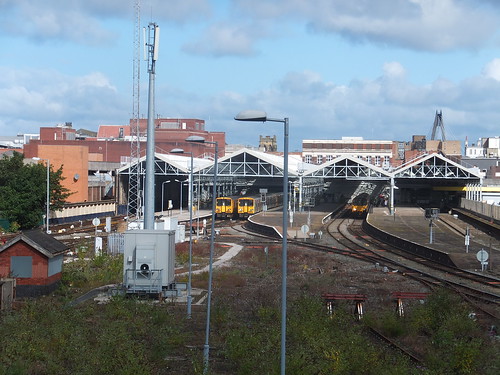 Southport station: The platforms on the left are used by Merseyrail, those on the right by Northern Rail.
Southport station: The platforms on the left are used by Merseyrail, those on the right by Northern Rail.
The building of the line between Southport and Liverpool gained parliamentary approval in 1847 as the Liverpool, Crosby and Southport Railway and opened the following year to temporary stations at both ends. There's a Wikipedia article here which links to articles on all the intermediate stations. In 1855 the railway became part of the Lancashire and Yorkshire Railway and was electrified in 1904. The permanent terminus in Southport was Southport Chapel Street, now simply 'Southport'. In Liverpool the line terminated at Liverpool Exchange. When both this terminus and the terminus at Liverpool Central were closed, British Railways drove a tunnel under the city centre so that electric trains from Southport could join up with the lines serving Liverpool Central (originally operated by the Cheshire Lines Committee - a joint venture by the Great Northern, Great Central and Midland Railways) and that route was electrified as far as Hunts Cross.
You can find out more about Liverpool Exchange at the splendid 'Disused Stations' site here. The impressive station frontage remains, as part of a commercial development.
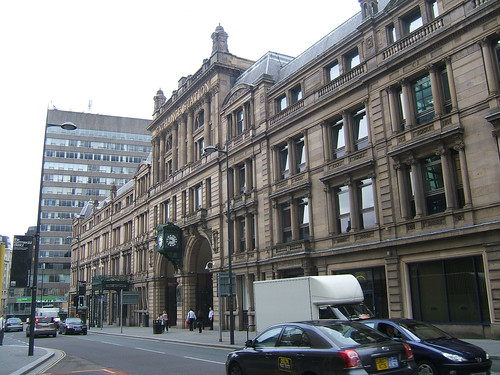 The extensive facade of the former Liverpool Exchange Station.
The extensive facade of the former Liverpool Exchange Station.
The 'Disused Stations' site also has information about Liverpool Central here.
Merseyrail trains on the Northern Line from Southport generally provide a service every 15 minutes stopping at all stations using Class 508 EMU. The whole Merseyrail network is now controlled from the Merseyrail Integrated Electronic Control Centre (IECC) at Sandhills.
It took around forty minutes to reach Moorfields where I left the train and descended to the deep level Wirral Line for the short journey to James Street. In bright sun, from the quay at Canning Dock I admired the preserved lightship 'Planet' which has a new role as a cafe/bar, events venue and museum, as shown on the website here.
 The preserved Lightship 'Planet' in Canning Dock, Liverpool.
The preserved Lightship 'Planet' in Canning Dock, Liverpool.
I couldn't resist continuing to the Museum of Liverpool to check on the exhibit of the 'Lion' locomotive and then taking a journey on the Mersey Ferry to Birkenhead Woodside. This was history repeating itself since I'd made the Museum visit followed by the Mersey Ferry trip on my earlier outing in March 2014 described here.
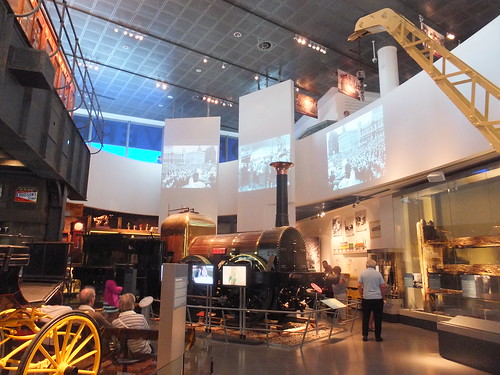 'Lion' in the Great Port Gallery.
'Lion' in the Great Port Gallery.
This time, the ferry was the 'Royal Iris of the Mersey'. I remembered the 'Royal Iris' and was puzzled by the 'of the Mersey' suffix. A bit of hunting subsequently showed that the ferry was originally 'Mountwood' (Wikipedia article here). The real 'Royal Iris' (which has a different design) is described here and currently languishes on the Thames as a derelict. An earlier campaign to repatriate her to the Mersey failed but the 'Liverpool Echo' recently reported a new initiative to bring the 'Royal Iris' back here.The 'Royal Iris of the Mersey' was absolutely packed but it was still a great trip.
 'Mountwood' now badged as 'Royal Iris of the Mersey'/
'Mountwood' now badged as 'Royal Iris of the Mersey'/
 'Royal Iris of the Mersey' disembarks a full load at the modernised Pierhead as we wait to board.
'Royal Iris of the Mersey' disembarks a full load at the modernised Pierhead as we wait to board.
Having recently written about Birkenhead (Woodside) station (Services to Birkenhead Woodside in Steam Days), I went to see what remains. I found the station throat, bricked-up approach tunnel, retaining walls and the base of the wall which had supported the arched station roof.
 The overgrown station throat at the former Birkenhead Woodside, viewed from the Church Street overbridge, showing the bricked-up tunnel mouth.
The overgrown station throat at the former Birkenhead Woodside, viewed from the Church Street overbridge, showing the bricked-up tunnel mouth.
In all the times I've travelled from Birkenhead Hamilton Square station, I couldn't remember actually visiting Hamilton Square itself. It's an impressive survivor - a grassed square with a monument to Queen Victoria in the form of an Eleanor Cross in sandstone from Darley Dale in the centre and the Town's Cenotaph near the Town Hall which, flanked by two short terraces of houses forms one side of the square then three blocks of elegant Georgian houses occupy the other three sides of the square. The Town Hall on the east side was built in 1883 and is Grade II*, the south side has a terrace of 17 Grade I houses built in 1839, the north-west terrace has 16 Grade I houses also built in 1839 and the earlier north-east terrace of 18 Grade I houses was built in 1825. All the houses are now in commercial occupation. Nearby, the Sessions Court built in 1885 in "enriched classical style" still serves as the Wirral Magistrates Court. The Wikipedia article here claims that only Trafalgar Square has more Grade 1 Listed Buildings at one location in England.
 Hamilton Square, Birkenhead: The 1825 terrace.
Hamilton Square, Birkenhead: The 1825 terrace.
Amazed by Hamilton Square, I walked back to Hamilton Square station, took the lift down to the Wirral Line and very soon the next train which would take me to Moorfields arrived.
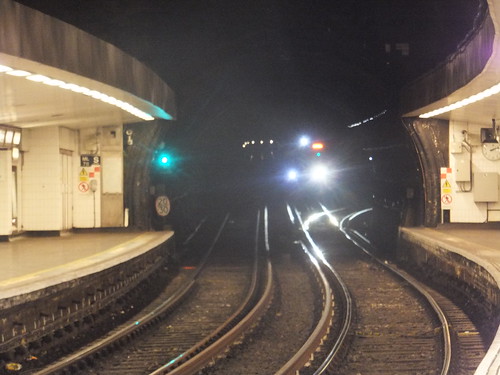 Birkenhead Hamilton Square: Looking towards Hooton from platform 1 showing my train arriving. The line diverging to the right is the Up West Kirby.
Birkenhead Hamilton Square: Looking towards Hooton from platform 1 showing my train arriving. The line diverging to the right is the Up West Kirby.
At Moorfields, I alighted at the single Deep Level platform and used the escalator to the Low Level station, catching the next train heading towards Ormskirk. I decided I had sufficient time to travel as far as Aintree. On leaving Sandhills, we turned right at Sandhills Junction on the Down Ormskirk, leaving the Southport lines on our left. After the Kirkdale Tunnels, we turned left at Walton Junction, leaving the Kirkby lines on our right.
I left the train at Aintree, where the former North Mersey branch appears through a set of gates. It's shown as 'Not In Regular Use' but it gave the appearance of having been abandoned years ago. I walked across the station car park and, just across the road, there was a pedestrian entrance to Aintree Racecourse. A few yards along I found the back of an appalling modern building. It was part of the two new grandstands opened for the 2007 Grand National meeting.
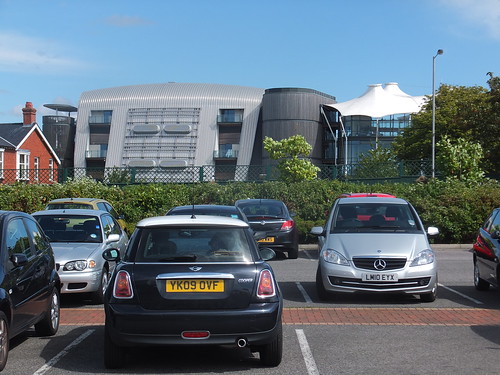 A study in ugliness: the rear of the new Aintree grandstand.
A study in ugliness: the rear of the new Aintree grandstand.
 This picture from grandnational.org shows the racecourse side of the new grandstands. No improvement on the rear, in my opinion.
This picture from grandnational.org shows the racecourse side of the new grandstands. No improvement on the rear, in my opinion.
The Grand National Website says of the new grandstands "The Earl of Derby and Lord Sefton grandstands were designed to offer first-class viewing facilities for the 21st century spectator, and both stands fit the brief perfectly" but I couldn't get over the ugliness and hurried back to the station to catch the first train back towards the city. This time, I left the train at Kirkdale where Merseyrail have a major depot.
 Kirkdale, showing the Merseyrail Depot.
Kirkdale, showing the Merseyrail Depot.
I left the station and walked north along Hawthorne Road. Side streets revealed long terraces of houses much more basic than Hamilton Square. Traditional shops were offering cheaper products. This is more the Liverpool I remember from past visits - a world away from the expensive apartments which proliferate nearer the City Centre. I made my way back to the station, tiring from the heat. I caught the next train to Kirkby.
 My Kirkby Train arrives at Kirkdale.
My Kirkby Train arrives at Kirkdale.
The Merseyrail network now is mainly double track but in the days of the Lancashire and Yorkshire Railway and its successor the L.M.S. many of the lines were 4-track in order to cope with both passenger and freight traffic. Leaving Liverpool Exchange and through Exchange Junction there were four lines (Down Fast, Up Fast, Down Slow, Up Slow). Beyond Sandhills No. 1, there were four lines towards Southport (Up East, Down East, Up West, Down West) and four towards Kirkdale (Down Fast, Up Fast, Down Slow, Up Slow). Kirkdale had extensive marshalling sidings which provided the land for the modern Merseyrail depot and the four tracks once continued to Walton Junction. Only two are needed for Merseyrail trains but the abandoned Kirkdale Tunnels are still visible. Continuing to Kirkby there is little hint that, around Fazakerley and Aintree, there were marshalling sidings rivalling those at Edge Hill, Liverpool (described here). I'll return to the Fazakerley/Aintree area when I can. About a mile short of Kirkby, the Up and Down lines merged into a single line. The Merseyrail train entered the platform at Kirkby and stopped. Of course, the Lancashire and Yorkshire line was double track through to Wigan Wallgate but there is now a physical break at Kirkby. Passengers alighting from the Merseyrail train wishing to travel onwards must walk down the platform to where, hopefully, the Northern Rail connecting service is waiting. Not so much fun if it's raining!
 Passengers walking from the Merseyrail train under the roadbridge to join the Northern Rail service.
Passengers walking from the Merseyrail train under the roadbridge to join the Northern Rail service.
 The Class 150 ready to take passengers from Kirkby.
The Class 150 ready to take passengers from Kirkby.
The Class 150 set off, travelling about five miles on single track and passing a single connection (controlled from a Ground Switch Panel) to Knowsley Freight Terminal operated by Potter Logistics. At Rainford Junction, double track resumed. The turnout and facing point lock was mechanically operated from the signal box and semaphore signals were in use. The L&Y style signal box once controlled a 3-way junction and had a 56-lever tappet frame. Behind the signal box, you can just make out the start of what was an LNWR branch to St. Helens. On the other side, I couldn't spot any sign of the Lancashire and Yorkshire Railway branch to Ormskirk.
 Rainford Junction Signal Box showing point rodding, semaphore bracket signal and (between the rails level with the signal) the TPWS 'Stop' loops.
Rainford Junction Signal Box showing point rodding, semaphore bracket signal and (between the rails level with the signal) the TPWS 'Stop' loops.
Another six miles and we were back at Wigan Wallgate. Tired but pleased with what I'd seen I walked back to Wigan North Western station and caught the first available service home.
Pre-grouping railways in West Lancashire
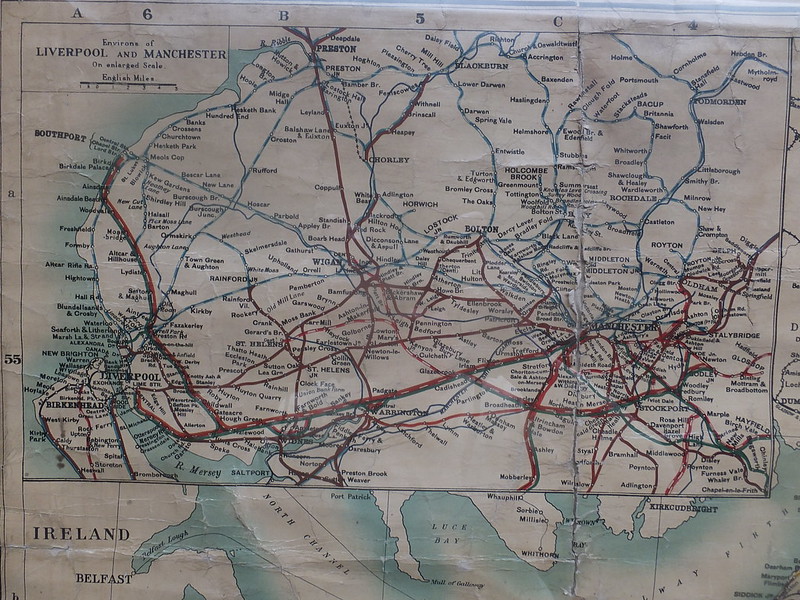 Click for larger view.
Click for larger view.My journey from Southport to Liverpool was on the former Lancashire and Yorkshire line (blue/white) to Moorfields where I changed Merseyrail's Wirral Line (originally the Mersey Railway) for the short trip to James Street. I then crossed the Mersey by ferry, returning from Hamilton Square to Moorfields. Here I took the former Lancashire and Yorkshire Railway to as far as Aintree on the line to Ormskirk, before returning to Kirkdale and taking the line to Kirkby where I changed to go forward to Wigan. Many of the railways on this map no longer exist.
 Railway Clearing House Map of Liverpool Railways.
Railway Clearing House Map of Liverpool Railways.Click for other sizes or to download.
My pictures
General pictures:
Liverpool.
Museum of Liverpool.
Birkenhead and its Docks.
Railway pictures:
Southport's Railways.
Merseyrail.
Lancashire & Yorkshire Railway in West Lancs.
